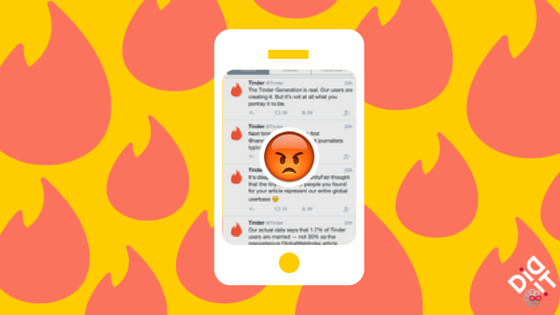
August 12, 2015: We’ve previously written about how social media and PR efforts can be synced in a way that encourages well-rounded publicity campaigns. Social media, in some ways, has elbowed out traditional public relations and journalist gatekeepers because of its innate ability to create a direct line between brands and customers. The problem with this — as the staff of Tinder is learning today — is that social media communications can sometimes come across as a little too casual, and actually work against a brand’s PR efforts.
Here’s what happened: at the beginning of the week, a fairly scathing Vanity Fair article entitled Tinder and the Dawn of the “Dating Apocalypse” went viral, appealing to Millennial-shamers, those who utter the phrase “back in my day,” and my mom. The article prominently referenced Tinder among other dating apps, resulting in a blow to some egos over at Tinder’s headquarters.
Which is why on Tuesday night, someone with access to Tinder’s Twitter account (I just cringed at that alliteration) went on a 31-tweet meltdown about how the app is actually helping the next generation of romantic lovers.
Hey @nancyjosales — that survey is incorrect. If you’re interested in having a factual conversation, we’re here. https://t.co/SLWlTLvJuf
— Tinder (@Tinder) August 11, 2015
Full of vaguely crude jokes, several mysterious “stats,” callouts of Nancy JoSales (the writer) and Vanity Fair, the rant went on to create a #GenerationTinder hashtag that very few people jumped on. Instead of restoring Tinder’s reputation, this very public meltdown succeeded only in making Tinder look clueless, defensive, uncool and… well, sad. Worse, it generated a huge second wave of negative press about Tinder that landed stories in the New York Times, Fortune, E! Online, and many other top-tier media outlets. This isn’t Tinder’s first PR disaster. In late 2014, Tinder made the #1 spot in Inc. Magazine’s expose of “Bro Culture,” thanks to a high-profile sexual harassment lawsuit filed by a female employee against its CEO ( which can’t be good news for a dating app whose business model depends on having both sexes feeling welcome on it). On social media, however, the lawsuit wasn’t even mentioned, much less addressed. Here are a few social media PR takeaways from Tinder’s gaffe:
- Respect opinions. Not everyone is going to be a fan of your product, especially online. Reach out to a complainer privately to see if you can mediate the issue.
- Illustrate your worth. Instead of referencing random “stats” or stories, prove the value that you have. Retweet supportive customers, take a video of someone who loves your product, or run a contest that will have users promoting your product.
- Emotions don’t translate well to text. Just like we’ve all learned from texting, sometimes typing your feelings just doesn’t cut it. These “tweet rants” usually just read as angry and boorish.
- Listen. Even in the most scathing complaints, some truth is often found. Are you working on a response that might help the issue?
- Have some personality. You probably see a lot of brands tweeting and signing with initials. People want to know that there’s a person behind that screen. A sense of humor is also very important to mediating a situation. Look at what Arby’s did to say goodbye to Jon Stewart. Even though the two had a tumultuous relationship, they handled the situation with humor and were able to jump on a trending topic with a unique angle.
- Say sorry. If you do have a meltdown, apologize to the right people. Always take the humble route.
- Sync your PR & social media team This is neither the first nor last social media disaster to hit a big brand. Your social media team, executives, and other stakeholders need to be media trained and aware of public relations best practices.
- Sometimes it makes sense to say nothing. If Tinder had simply kept mum for a couple of days and allowed the Vanity Fair story to run its course, it would have completely avoided the giant secondary wave of negative press coverage that swamped it through the middle of this week. But by injecting itself aggressively and bluntly into the conversation, Tinder showed social media lurkers on Twitter that it had been truly stung by Vanity Fair’s negative reportage, which became a story in itself. Word to the wise: just because Donald Trump can get away with shooting his mouth off on Twitter without aiming anywhere doesn’t mean you can.
- 10 Mistakes to Avoid When Using QR Codes for Marketing - September 20, 2023
- Kevin Lee on How AI Changes the SEO Landscape - August 31, 2023
- The Power of Compound Marketing: Kevin Lee Presents @ 1MediaWorld 2023 Global Conference - March 7, 2023
